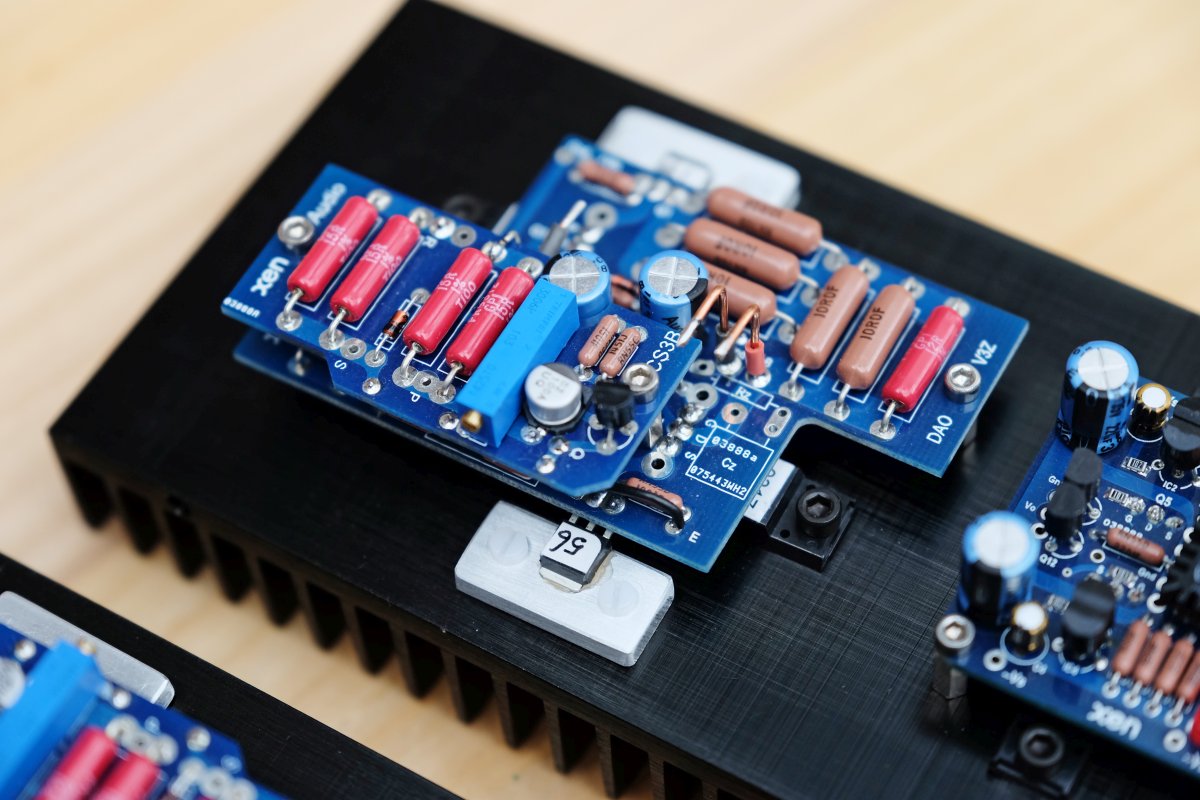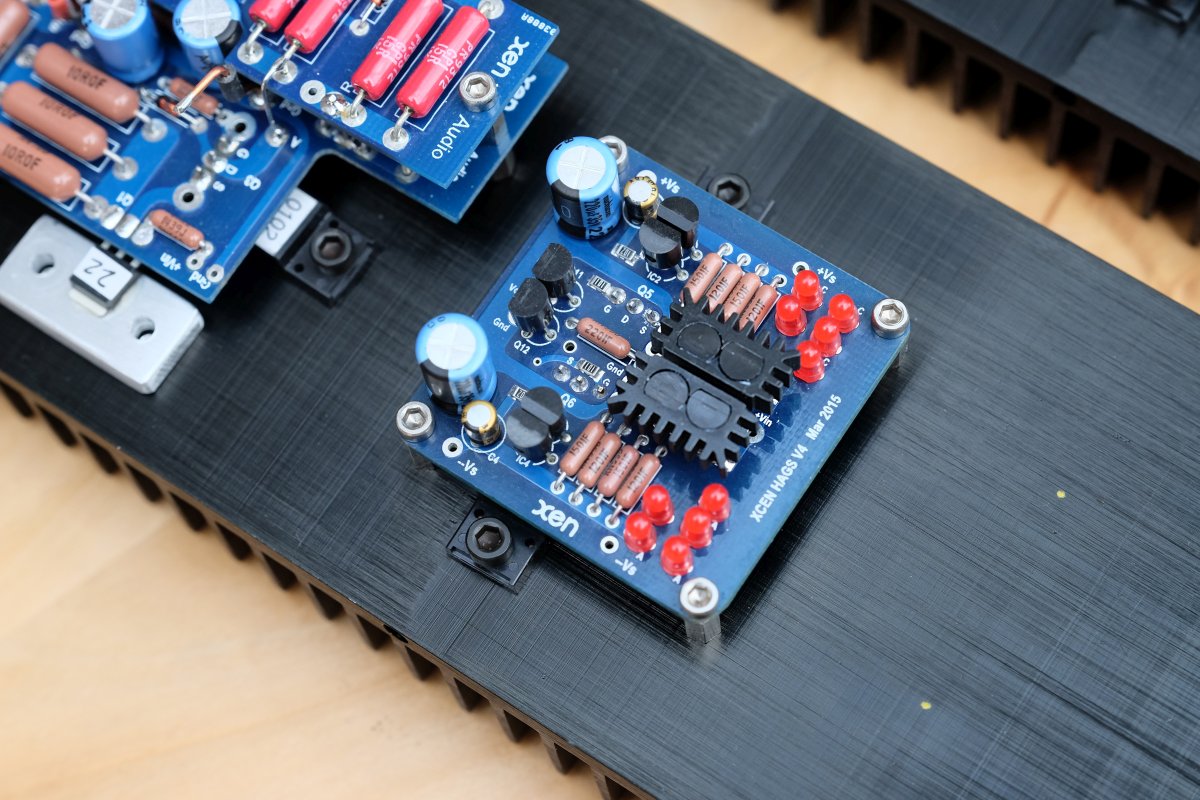DAO
The year 2016 brought the arrival of the DAO (--> literally meaning 'The Path' in chinese language, but also referring to the philosophical concept of the 'Dao' 道 ), an all FET, Zero-Global-Feedback, Pure Class-A headphone amplifier. It is yet another creation out of the XEN stable and another brainchild of the man known as 'EUVL', and their most complex published design yet.
Similar to the F5 HA the DAO headphone amplifier is originally based on Nelson Pass' tinkering with circuit ideas, in this case about using a Power JFET from the (no longer existing) company Lovoltech, the LU1014D. Thinking of using them in a power amplifier he came up with a circuit describing how the triode characteristics of this particular Power JFET could be put to use with so called Cascode-Modulation. Since I cannot lay out all the details and information in depth I kindly ask those interested more in the topic to have a look at the information posted on the DAO thread on Diyaudio or in the original articles in Nelson's ZEN Version 8 and 9 papers.
Patrick aka EUVL transformed the circuit idea and put them to use in a headphone amplifier by cleverly balancing cascode voltage and cascode modulation while keeping bias at 200mA. The cascoded LU1014D thus became an ideal candidate for a Source Follower Headphone Buffer circuit. To provide more driving power the original buffer was augmented with a Taylor Current Source (TCS), and to make the design more versatile with headphones of any impedance (I am using headphones with 60 Ohm and 350 Ohm impedance) it employs an additional gain stage (HAGS) to provide a gain of 5, all without Global Feedback and in pure Class A. Those modules are forming the amplifier section.
On the input side I had the choice of three different Crossfeed circuits (optional) --> the Meier circuit, the popular Linkwitz and a modified Danyuk version. I choose the passive Danyuk Crossfeed followed by a simple JFET buffer.
Parts quality in general is the highest I ever used in a project with all semiconductors curve traced and matched to extremely low tolerances by the XEN team. Resistors are all 1% with the exception of the Crossfeed circuit that uses Vishay S102 foil resistors (0.1% tolerance) and tightly matched Wima film capacitors.
 TCS and Source Follower
TCS and Source Follower
 HAGS
HAGS
The DAO headphone amplifier is working with a rail voltage of +/- 24V that can be provided in many ways. The design is deliberately kept flexible by EUVL to adapt to the needs and wishes of the individual builder. Power supplies can range from a simple CRC supply to LiPo batteries, which were my first choice in the beginning but honestly I couldn't figure out how to house the needed 12 battery packs and their balanced charging circuit inside the given case... So instead I choose a CregC supply that consists of two capacitor boards with 80.000uF of capacitance and four Curl cap multipliers nested inside to power the Source Follower, TCS and HAGS. The Danyuk Crossfeed or the buffer respectively, requiring +/- 9V is fed by a pair of very compact Didden regulators employing no less than 32 SMD parts crammed on each board. Because of the tight layout a premium quality, magnetically shielded toroid is highly recommended. Mine came custom made from german company Rondo Mueller and fit the task perfectly.
Building took a little longer than expected, but then this is not something you are building in a hurry. It definitely helps to have a good understanding of circuit theory, and I learned my lessons here by reading up on the subject or simply following P.'s explanations. Also no less than 17 compact boards had to be populated and tested... but except for a silly wiring mistake on the headphone jack everything worked as intended during the first test run.
Now, is this finally audio nirvana?
When I am looking back to the year 2004 I think I have come quite a long way... I built a good dozen headphone amplifiers of various topologies and listened to all of them extensively while often comparing them side by side. Human as it is I often thought that I had reached the summit of performance already... just being very proud of a just finished amplifier.
With the DAO my personal and subjective quest for "best" sound has come to an end as it seems, unless I do a major system change. There is virtually no critizism possible with the DAO... while all the other headphone amplifiers had one or the other weak point or attribute I didn't like so much, even being really subtle, the DAO does everything right.
It portrays music in a way that to my ears leaves nothing to be desired, and the limitation is coming rather from the recording quality of a certain track or from the headphones in use. It has vanishingly low distortion (also measured), a fullbodied and natural timbre and imaging as good as it gets with headphones on your head. Listening to it everything falls into place... there is nothing missing nor anything standing out.
There is nothing I would need to add.
